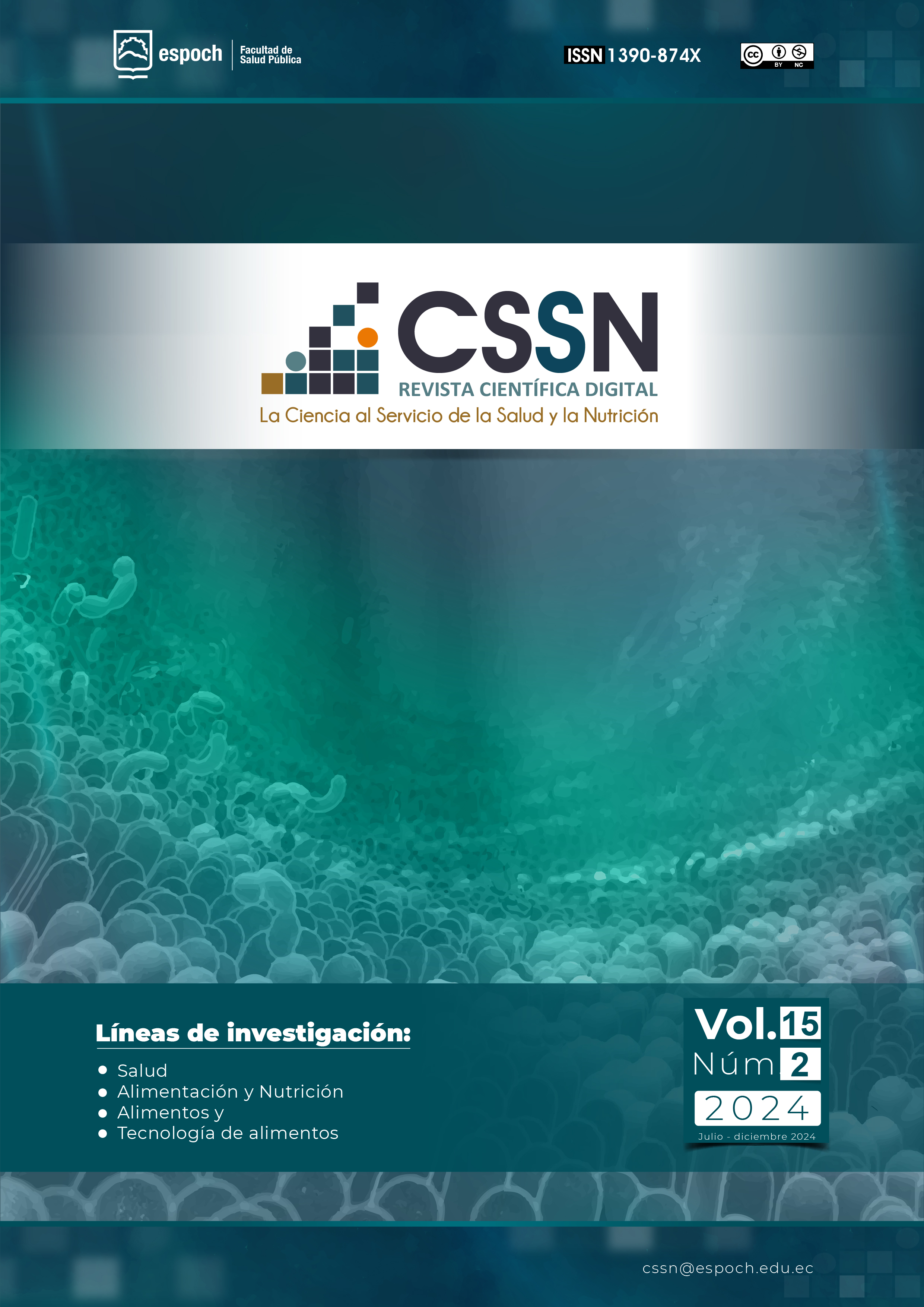Metabolic surgery experience in obese patients in a private hospital in Baños-Tungurahua during 2021-2022
DOI:
https://doi.org/10.47187/cssn.Vol15.Iss2.351Keywords:
bariatric surgery, morbid obesity, weight loss, comorbidity, diseases, early experienceAbstract
Introducción: Son escasas las publicaciones respecto a experiencia inicial en cirugía bariátrica laparoscópica en el Ecuador. Es imprescindible empezar con criterios de calidad en cirugía bariátrica tanto para los cirujanos como con programas formales para las instituciones donde se la realice. Objetivo: Describir la experiencia inicial y los resultados a corto-mediano plazo con procedimientos bariátricos metabólicoslaparoscópicos en Ecuador. Metodología: Se realizó un estudio descriptivo, observacional y retrospectivo en 31 pacientes sometidos a cirugía bariátrica en el Hospital Privado Surgimed en Baños de Agua Santa, Tungurahua, desde septiembre de 2021 hasta mayo de 2022. Se revisaron expedientes clínicos para extracción de datos y se utilizó análisis estadístico descriptivo y bivariado para evaluar los resultados. Resultados: La mayoría de los pacientes eran mujeres (83,9%), con una mediana de edad de 30 años. El peso preoperatorio promedio fue de 95,09 Kg, y la mediana de IMC de 36,67 Kg/m2. Las comorbilidades incluyeron diabetes (16,1%), hipertensión (3,2%), dislipidemia (77,4%) y esteatosis (67,7%). La pérdida de peso total promedio al 1, 3 y 6 meses fue del 12,53%, 22,10% y 30,02% respectivamente. Todos los pacientes normalizaron sus niveles de glucosa un mes después de la cirugía. Discusión: Los procedimientos bariátricos demostraron ser
efectivos para reducir el peso y mejorar las comorbilidades con escasas complicaciones desde la experiencia inicial, alineados con la literatura existente. Conclusiones: Podemos concluir que siguiendo las guias estandarizadas de sociedades científicas de cirugia bariátrica se logra obtener resultados similares a los descritos en estudios internacionales incluso desde la experiencia inicial.
Downloads
References
Albuquerque D, Nóbrega C, Manco L, Padez C. The contribution of genetics and environment to obesity. Br Med Bull. 2017;123:159–73.
Janković D, Wolf P, Anderwald CH, Winhofer Y, Promintzer-Schifferl M, Hofer A, et al. Prevalence of endocrine disorders in morbidly obese patients and the effects of bariatric surgery on endocrine and metabolic parameters. Obes Surg. 2012;22:62–9.
Ackerman SE, Blackburn OA, Marchildon F, Cohen P. Insights into the Link Between Obesity and Cancer. Curr Obes Rep. 2017;6:195–203. Obesidad y sobrepeso n.d.
World Obesity Atlas 2022 | World Obesity Federation n.d. World Obesity Federation, https://data.worldobesity.org/publications/?cat=19
Patricio Vargas Córdova R, del Consuelo Arias Trujillo A, Toledo X, Médico HGSF Mgs Carmen Alarcón D, Administrativa HGSF D, Cevallos M, et al. Evaluación integral del paciente con obesidad candidato a cirugía bariátrica– endócrino metabólica. Revista Médica-Científica CAMbios HECAM. 2021;20:99–106.
Pérez-Galarza J, Baldeón L, Franco OH, Muka T, Drexhage HA, Voortman T, et al. Prevalence of overweight and metabolic syndrome, and associated sociodemographic factors among adult Ecuadorian populations: the ENSANUT-ECU study. Journal of Endocrinological Investigation. 2021;44:63–74.
Verdugo Tapia JC, Moscoso Toral EA, Tenezaca Tacuri ÁH, Pesantez Mendez CG, Arévalo Espinoza PS. Estudio Descriptivo: Utilidad de la Cirugía Bariátrica en el Tratamiento de la Obesidad y Comorbilidades en Pacientes del Hospital de Especialidades José Carrasco Arteaga, 2009 - 2013. Revista Médica del Hospital José Carrasco Arteaga. 2017;9:28–35.
Vista de Evaluación de la calidad de vida post cirugía bariátrica mediante la aplicación del SCORE DE BAROS en el hospital General Enrique Garcés -Quito. enero – marzo 2013. n.d.
Velecela MO. Impacto post quirúrgico de la cirugía bariátrica y comorbilidades asociadas. Hospital José Carrasco Arteaga: Cuenca-Ecuador, 2014-2018 2021.
“Esther Martín García - Almenta,” “Jaime Ruiz-Tovar Polo”, Raquel Sánchez Santos. Vía Clínica de Cirugía Bariátrica. ed. Albacete: Im3diA comunicación S.L.; 2017.
Brethauer SA, Kim J, el Chaar M, Papasavas P, Eisenberg D, Rogers A, et al. Standardized outcomes reporting in metabolic and bariatric surgery. Surg Obes Relat Dis. 2015;11:489–506.
Ahmed OS, Rogers AC, Bolger JC, Mastrosimone A, Robb WB. Meta-Analysis of Enhanced Recovery Protocols in Bariatric Surgery. J Gastrointest Surg. 2018;22:964–72.
Sabench Pereferrer F, Domínguez-Adame Lanuza E, Ibarzabal A, Socas Macias M, Valentí Azcárate V, García Ruiz de Gordejuela A, et al. Quality criteria in bariatric surgery: Consensus review and recommendations of the Spanish Association of Surgeons and the Spanish Society of Bariatric Surgery. Cirugia espanola. 2017;95:4–16.
DeMaria EJ, el Chaar M, Rogers AM, Eisenberg D, Kallies KJ, Kothari SN. American Society for Metabolic and Bariatric Surgery position statement on accreditation of bariatric surgery centers endorsed by the Society of American Gastrointestinal and Endoscopic Surgeons. Surg Obes Relat Dis. 2016;12:946–54.
Arterburn DE, Courcoulas AP. Bariatric surgery for obesity and metabolic conditions in adults. BMJ (Online). 2014;349.
Rubino F, Kaplan LM, Schauer PR, Cummings DE. The Diabetes Surgery Summit consensus conference: recommendations for the evaluation and use of gastrointestinal surgery to treat type 2 diabetes mellitus. Ann Surg. 2010;251:399–405.
Consensus statement from the U.A. national institutes of health (nih) gastrointestinal surgery for severe obesity. International Journal of Technology Assessment in Health Care. 1992;8:553.
de Luca M, Angrisani L, Himpens J, Busetto L, Scopinaro N, Weiner R, et al. Indications for Surgery for Obesity and Weight-Related Diseases: Position Statements from the International Federation for the Surgery of Obesity and Metabolic Disorders (IFSO). Obes Surg. 2016;26:1659–96.
Reis CEG, Alvarez-Leite JI, Bressan J, Alfenas RC. Role of bariatric-metabolic surgery in the treatment of obese type 2 diabetes with body mass index <35kg/m 2: A literature review. Diabetes Technology and Therapeutics. 2012;14:365–72.
Parikh M, Issa R, Vieira D, McMacken M, Saunders JK, Ude-Welcome A, et al. Role of bariatric surgery as treatment for type 2 diabetes in patients who do not meet current NIH Criteria: A systematic review and meta-analysis. J Am Coll Surg. 2013;217.
Li Q, Chen L, Yang Z, Ye Z, Huang Y, He M, et al. Metabolic effects of bariatric surgery in type 2 diabetic patients with body mass index < 35 kg/m2. Diabetes, Obesity and Metabolism. 2012;14:262–70.
Ali M, el Chaar M, Ghiassi S, Rogers AM. American Society for Metabolic and Bariatric Surgery updated position statement on sleeve gastrectomy as a bariatric procedure. Surg Obes Relat Dis. 2017;13:1652–7.
Carbajo MA, Luque-de-León E, Jiménez JM, Ortiz-de-Solórzano J, Pérez-Miranda M, Castro-Alija MJ. Laparoscopic One-Anastomosis Gastric Bypass: Technique, Results, and Long-Term Follow-Up in 1200 Patients. Obes Surg. 2017;27:1153–67.
Carbajo MA, Luque-de-León E. Mini-gastric bypass/one-anastomosis gastric bypass—standardizing the name. Obes Surg. 2015;25:858–9.
Georgiadou D, Sergentanis TN, Nixon A, Diamantis T, Tsigris C, Psaltopoulou T. Efficacy and safety of laparoscopic mini gastric bypass. A systematic review. Surgery for Obesity and Related Diseases. 2014;10:984–91.
García-Caballero M, Carbajo M. One anastomosis gastric bypass: a simple, safe and efficient surgical procedure for treating morbid obesity. Nutrición hospitalaria : organo oficial de la Sociedad Española de Nutrición Parenteral y Enteral. 2004;19:372–5.
Mini-gastric bypass/one-anastomosis gastric bypass—standardizing the name - PubMed n.d.
Carbajo M, García-Caballero M, Toledano M, Osorio D, García-Lanza C, Carmona JA. One-anastomosis gastric bypass by laparoscopy: results of the first 209 patients. Obes Surg. 2005;15:398–404.
Borjas G, Gonzalez M, Maldonado A, Urdaneta A, Ramos E. Oversewing staple line of the gastric remnant in gastric bypass reduces postoperative bleeding. Ann Med Surg (Lond). 2021;67:102534.
Reinforcement of the Staple Line during Gastric Sleeve: A Comparison of Buttressing or Oversewing, versus No Reinforcement- A Single-Institution Study - PubMed n.d.
Sepúlveda M, Astorga C, Hermosilla JP, Alamo M. Staple Line Reinforcement in Laparoscopic SleeveGastrectomy: Experience in 1023 Consecutive Cases. Obesity Surgery. 2017;27:1474–80.
Ramos AC ardoso, Silva AC arlo S, Ramos MG alvão, Canseco EG onzalo C, Galvão-Neto M dos P, Menezes M de A, et al. SIMPLIFIED GASTRIC BYPASS: 13 YEARS OF EXPERIENCE AND 12,000 PATIENTS OPERATED. Arquivos Brasileiros de Cirurgia Digestiva : ABCD = Brazilian Archives of Digestive Surgery. 2014;27:2.
Clavien PA, Barkun J, de Oliveira ML, Vauthey JN, Dindo D, Schulick RD, et al. The clavien-dindo classification of surgical complications: Five-year experience. Annals of Surgery. 2009;250:187–96.
Frühbeck G. Bariatric and metabolic surgery: a shift in eligibility and success criteria. Nat Rev Endocrinol. 2015;11:465–77.
Pories WJ, Swanson MS, MacDonald KG, Long SB, Morris PG, Brown BM, et al. Who would have thought it? An operation proves to be the most effective therapy for adult-onset diabetes mellitus. Ann Surg. 1995;222:339–52.
Mingrone G, Panunzi S, de Gaetano A, Guidone C, Iaconelli A, Nanni G, et al. Bariatric-metabolic surgery versus conventional medical treatment in obese patients with type 2 diabetes: 5 year follow-up of an open-label, single-centre, randomised controlled trial. Lancet. 2015;386:964–73.
Buchwald H, Estok R, Fahrbach K, Banel D, Jensen MD, Pories WJ, et al. Weight and type 2 diabetes after bariatric surgery: systematic review and meta-analysis. Am J Med. 2009;122.
Rubio MA, Monereo S, Lecube A, Resa J, Masdevall C, de la Cruz Vigo F, et al. [Joint Position Statement of the SEEN-SECO-SEEDO-SED Societies on metabolic surgery for type 2 diabetes mellitus"]. Endocrinologia y nutricion : organo de la Sociedad Espanola de Endocrinologia y Nutricion. 2013;60:547–8.
Virdis A. Endothelial Dysfunction in Obesity: Role of Inflammation. High Blood Press Cardiovasc Prev. 2016;23:83–5.
Tareke AA, Hadgu AA. The effect of vitamin C supplementation on lipid profile of type 2 diabetic patients: a systematic review and meta-analysis of clinical trials. Diabetol Metab Syndr. 2021;13:24.
Cui M, Trimigno A, Castro-Mejía JL, Reitelseder S, Bülow J, Bechshøft RL, et al. Human Fecal Metabolome Reflects Differences in Body Mass Index, Physical Fitness, and Blood Lipoproteins in Healthy Older Adults. Metabolites. 2021;11.
Rashid S, Genest J. Effect of obesity on high-density lipoprotein metabolism. Obesity. 2007;15:2875–88.
Mooradian AD, Haas MJ, Wehmeier KR, Wong NCW. Obesity-related changes in high-density lipoprotein metabolism. Obesity (Silver Spring). 2008;16:1152–60.
Toshniwal G, McKelvey GM, Wang H. STOP-Bang and prediction of difficult airway in obese patients. J Clin Anesth. 2014;26:360–7.
Thota B, Jan KM, Oh MW, Moon TS. Airway management in patients with obesity. Saudi J Anaesth. 2022;16:76–81.
Chung F, Abdullah HR, Liao P. STOP-bang questionnaire a practical approach to screen for obstructive sleep apnea. Chest. 2016;149:631–8.
Consensus statement from the U.A. national institutes of health (nih) gastrointestinal surgery for severe obesity. International Journal of Technology Assessment in Health Care. 1992;8.
Azagury D, Morton JM. Bariatric Surgery Outcomes in US Accredited vs Non-Accredited Centers: A Systematic Review. J Am Coll Surg. 2016;223:469–77.
Published
How to Cite
Issue
Section
License
Copyright (c) 2025 LA CIENCIA AL SERVICIO DE LA SALUD Y NUTRICIÓN

This work is licensed under a Creative Commons Attribution-NonCommercial 4.0 International License.




